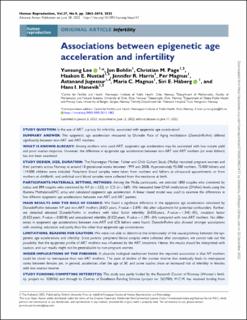| dc.description.abstract | Study question: Is the use of ART, a proxy for infertility, associated with epigenetic age acceleration? Summary answer: The epigenetic age acceleration measured by Dunedin Pace of Aging methylation (DunedinPoAm) differed significantly between non-ART and ART mothers. What is known already: Among mothers who used ART, epigenetic age acceleration may be associated with low oocyte yield and poor ovarian response. However, the difference in epigenetic age acceleration between non-ART and ART mothers (or even fathers) has not been examined. Study design, size, duration: The Norwegian Mother, Father and Child Cohort Study (MoBa) recruited pregnant women and their partners across Norway at around 18 gestational weeks between 1999 and 2008. Approximately 95 000 mothers, 75 000 fathers and 114 000 children were included. Peripheral blood samples were taken from mothers and fathers at ultrasound appointments or from mothers at childbirth, and umbilical cord blood samples were collected from the newborns at birth. Participants/materials, setting, methods: Among the MoBa participants, we selected 1000 couples who conceived by coitus and 894 couples who conceived by IVF (n = 525) or ICSI (n = 369). We measured their DNA methylation (DNAm) levels using the Illumina MethylationEPIC array and calculated epigenetic age acceleration. A linear mixed model was used to examine the differences in five different epigenetic age accelerations between non-ART and ART parents. Main results and the role of chance: We found a significant difference in the epigenetic age acceleration calculated by DunedinPoAm between IVF and non-ART mothers (0.021 years, P-value = 2.89E-06) after adjustment for potential confounders. Further, we detected elevated DunedinPoAm in mothers with tubal factor infertility (0.030 years, P-value = 1.34E-05), ovulation factor (0.023 years, P-value = 0.0018) and unexplained infertility (0.023 years, P-value = 1.39E-04) compared with non-ART mothers. No differences in epigenetic age accelerations between non-ART and ICSI fathers were found. DunedinPoAm also showed stronger associations with smoking, education and parity than the other four epigenetic age accelerations. Limitations, reasons for caution: We were not able to determine the directionality of the causal pathway between the epigenetic age accelerations and infertility. Since parents' peripheral blood samples were collected after conception, we cannot rule out the possibility that the epigenetic profile of ART mothers was influenced by the ART treatment. Hence, the results should be interpreted with caution, and our results might not be generalizable to non-pregnant women. Wider implications of the findings: A plausible biological mechanism behind the reported association is that IVF mothers could be closer to menopause than non-ART mothers. The pace of decline of the ovarian reserve that eventually leads to menopause varies between females yet, in general, accelerates after the age of 30, and some studies show an increased risk of infertility in females with low ovarian reserve. Study funding/competing interest(s): This study was partly funded by the Research Council of Norway (Women's fertility, project no. 320656) and through its Centres of Excellence Funding Scheme (project no. 262700). M.C.M. has received funding from the European Research Council (ERC) under the European Union's Horizon 2020 research and innovation programme (grant agreement number 947684). The authors declare no conflict of interest. | |
